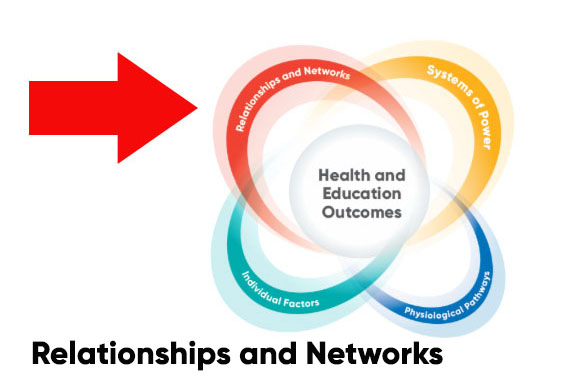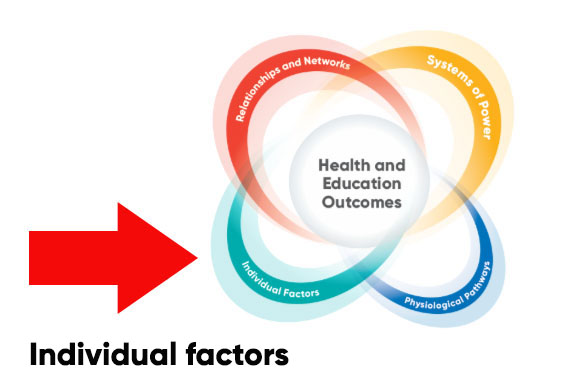ETR's Health Equity Framework in Practice: HealthSmart
By Suzanne Schrag | August 31, 2018
JJ is 11 years old and on the way to school. JJ usually stops at the bodega to buy a candy bar for a snack. But today is different. This week JJ is learning in school about increasing your heart rate through physical activity to stay healthy. So, instead of stopping at the bodega, JJ runs around the block three times. JJ shows up to school a little sweaty but excited and energized.
Alika is 9 years old and is learning about the vitamins and minerals in fresh food that keep you healthy. But Alika notices that there are no fresh fruits or vegetables at the school. Over the weekend, Alika and mom go to a few of the local farmers' markets and ask for donations for the school. On Monday, Alika and mom arrive with grocery bags full of apples, carrots and oranges to share with Alika's classmates and teachers.
What do these students have in common? They are using their health knowledge to exercise personal agency and make their own and their community’s health better.
HealthSmart: A Call to Health Equity
HealthSmart, ETR’s comprehensive K-12 health education program, offers many features that make its lessons relevant to children of all backgrounds and experiences. Our longstanding focus on health equity has informed the development of this program from the outset. Today, we are operationalizing that focus with even greater precision, with the help of ETR’s Health Equity Framework (HEF).
ETR’s Health Equity Framework
.png) The Health Equity Framework is a tool that helps us be more intentional and grounded about issues of health equity in all of our projects. It highlights four interconnected factors that influence health and determine the presence, or absence, of health equity. These factors are (1) individual factors; (2) relationships and networks; (3) systems of power; and (4) physiological pathways.
The Health Equity Framework is a tool that helps us be more intentional and grounded about issues of health equity in all of our projects. It highlights four interconnected factors that influence health and determine the presence, or absence, of health equity. These factors are (1) individual factors; (2) relationships and networks; (3) systems of power; and (4) physiological pathways.
When health equity is present, individuals and communities have the personal agency and fair access they need to resources and opportunities. These, in turn, bring about the best possible health outcomes in physical, emotional and social realms.
When health disparities exist, they reflect preventable differences in outcomes closely related to our social, economic and physical environments.
HealthSmart has been ETR’s signature evidence-informed, comprehensive health education curriculum since it was first published in 2001. With the completion of the second edition of the elementary grades in Fall 2017, the full HealthSmart program is now available in an updated and expanded edition that aligns to the CDC’s Health Education Curriculum Analysis Tool (HECAT) and National Health Education Standards.
HealthSmart incorporates all of the Characteristics of Effective Health Education Curricula defined by the CDC. It addresses the major health risks faced by children and youth. It teaches the functional knowledge and skills children and adolescents need to achieve health literacy and focuses on the key healthy behavior outcomes outlined in the HECAT for nine health content areas.
What are “functional knowledge and skills”?
Functional knowledge covers facts and concepts that are essential to making healthy decisions and practicing health-enhancing behaviors.
For example, learning about the circulatory system is interesting, and drawing a map of the blood vessels might be a fun project. But these aren’t really going to help address the health risk of inadequate physical activity. On the other hand, knowing that activities that make your heart beat faster and your lungs breathe harder help you stay healthy, and then setting a goal to be active for 60 minutes a day, can make a difference.
How Does HealthSmart Fit Within the Health Equity Framework?
HealthSmart provides children and adolescents with knowledge and skills to build health literacy and achieve lifelong physical, emotional and social health. It employs strategies that enhance a student’s personal agency to achieve health equity. HealthSmart students learn information, practice essential skills and find opportunities to identify and access resources to support their health. They build personal efficacy to succeed in their efforts.
Used as a school-based program, HealthSmart has the power to reach all students. The curriculum encourages students to draw upon their own knowledge and experiences. It offers many opportunities for students to personalize learning in ways that make sense in the context of their lives.
It also helps students communicate with trusted adults, access community resources and shape healthy peer norms to build support for healthy choices and behaviors. Health educators and schools can support students going through the HealthSmart program by helping them and their families identify accessible and affordable health and social services in their community.
Here are some specific examples of the ways HealthSmart integrates the Health Equity Framework in practice.
Example: Relationships and Networks
 In the HEF factor of Relationships and Networks, HealthSmart helps students build support systems within their families, peer group and community that encourage practice of healthy behaviors. Take-home family sheets (in English and Spanish) ensure that parents and caregivers understand what is being taught in class. They can support health-promoting choices at home. Activities explore and help establish healthy peer norms, contributing to support for healthy behaviors.
In the HEF factor of Relationships and Networks, HealthSmart helps students build support systems within their families, peer group and community that encourage practice of healthy behaviors. Take-home family sheets (in English and Spanish) ensure that parents and caregivers understand what is being taught in class. They can support health-promoting choices at home. Activities explore and help establish healthy peer norms, contributing to support for healthy behaviors.
Example: Individual Factors
 In the HEF factor of Individual Factors, HealthSmart lessons are grounded in the Theory of Planned Behavior. This essentially says that when individuals build positive personal attitudes toward a particular health behavior, and family, peer and community norms support this healthy behavior, the individual has a stronger sense of control and the confidence to act in healthy ways.
In the HEF factor of Individual Factors, HealthSmart lessons are grounded in the Theory of Planned Behavior. This essentially says that when individuals build positive personal attitudes toward a particular health behavior, and family, peer and community norms support this healthy behavior, the individual has a stronger sense of control and the confidence to act in healthy ways.
Among children and adolescents in Grades K through 12, we find youth along a wide spectrum of health and educational disparities. HealthSmart can build health literacy across this entire population, empowering individual youth with the knowledge and skills to make healthy behavior choices.
A Powerful Way to Support Health Equity
A school-based health curriculum cannot remedy all social and economic inequities. However, it can empower students to address larger issues in their lives.
For example, the advocacy activities in the HealthSmart program plant future seeds for addressing systems of power. Young people learn and practice skills that will help them speak up and stand up for the things that will support health for themselves and their peers, now and in the future.
HealthSmart has taken an innovative, science-based approach to comprehensive health education that is unique among health education programs. We believe all students are entitled to health education that is meaningful, interesting and relevant to their lives and developmental stage. This is one reason HealthSmart developers have applied a health equity lens to the program.
Read More About HealthSmart
You can learn more about this program at the HealthSmart website. A number of previous posts on our blog explain the HealthSmart approach in detail.
Suzanne Schrag is the series editor of the second edition of the HealthSmart program, and a co-author of the newly-revised K-5 grade levels.




